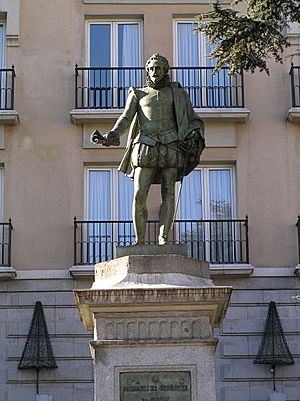Statue of Cervantes (Madrid) facts for kids
 |
|
| Coordinates | 40°24′57″N 3°41′47″W / 40.415751°N 3.696474°W |
|---|---|
| Location | Plaza de las Cortes, Madrid, Spain |
| Designer | Antonio Solá (statue) José Piquer Duart (reliefs) Isidro González Velázquez (pedestal) |
| Material | Bronze, granite, limestone |
| Opening date | 1835 |
| Dedicated to | Miguel de Cervantes |
The Miguel de Cervantes statue, also known as the Statue of Cervantes, is a famous piece of public art in Madrid, Spain. It was put up in 1835 to honor Miguel de Cervantes Saavedra, a very important Spanish writer. You can find this statue in the Plaza de las Cortes, right in front of the Congress of Deputies, which is where Spain's government meets.
Contents
Discovering the Cervantes Statue
How the Statue Was Planned
The idea for a statue honoring Cervantes started in 1831. A nobleman called the Duke of San Fernando talked to a sculptor named Antonio Solá about making it. The Duke asked King Ferdinand VII for permission. However, the King decided to take over the project himself. He put Manuel Fernández Varela in charge of finding money for the monument.
What the Statue Looks Like
The main statue of Cervantes is made of bronze. It was created by Antonio Solá in Rome and arrived in Madrid in 1835. The statue shows Cervantes standing up. His right leg is slightly bent, and he holds a roll of papers in his right hand. His left hand rests on the handle of his sword. He is dressed in clothes from his time, including Spanish breeches, a buttoned-up jacket, a ruff (a pleated collar), and a short cape.
Where the Statue Stands
When it first arrived, the statue was placed temporarily in a different spot called Plaza del Duque de Nájera. But by July 1835, it was moved to its permanent home in the Plaza de las Cortes.
The base of the statue, called the pedestal, was designed by Isidro Velázquez. The front and back of the pedestal have two bronze plaques. One plaque is in Latin and says "To Michael de Cervantes Saavedra, Prince of Spanish Writers, Year 1835." The other plaque is the Spanish translation of this message.
The sides of the pedestal are made of limestone and granite. They feature two bronze carvings by José Piquer Duart. These carvings show scenes from Cervantes' most famous book, Don Quixote de la Mancha. On the left side, you can see the adventure with the lions. On the right side, it shows Don Quixote and Sancho Panza being led by the goddess of madness. The round base that the pedestal sits on is made of granite.
Gifts to Other Cities
Between 1981 and 1986, when Enrique Tierno Galván was the mayor of Madrid, four copies of the bronze statue were given as gifts. These copies were sent to New York, Moscow, Beijing, and La Paz.
A Hidden Time Capsule
In 2009, the statue's exact spot in the Plaza de las Cortes was changed slightly. During this work, something amazing was found: a time capsule! Inside the capsule were four copies of Don Quixote, an old law document from 1834 called the 1834 Royal Statute, two newspapers, and two government papers like the Gaceta de Madrid and the Diario de Avisos. There was also a handwritten paper and a book called Guía del Forastero. This discovery gave us a peek into the past!
See also
 In Spanish: Estatua de Cervantes (Madrid) para niños
In Spanish: Estatua de Cervantes (Madrid) para niños

